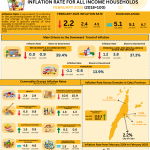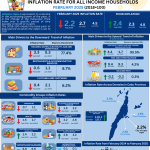Starting February 2022, the Philippine Statistics Authority (PSA) released the rebased Consumer Price Index (CPI) for all income households to base year 2018, from base year 2012 as announced in the press release number 2022-01 dated 04 January 2022. The CPI series for all income households for January 2023 onwards will be 2018-based.

1. Philippines
The country’s inflation rate has decreased from 8.6 percent in February 2023 to 7.6 percent in March 2023. In March of the previous year, inflation was lower at 4.0 percent. (Table 1)
2. Central Visayas
Following the trend at the national level, the inflation rate in Central Visayas has decreased to 6.6 percent in March 2023 from 7.4 percent in February 2023. In March 2022, inflation in the region was recorded at 5. percent. (Table 1)
3. Negros Oriental
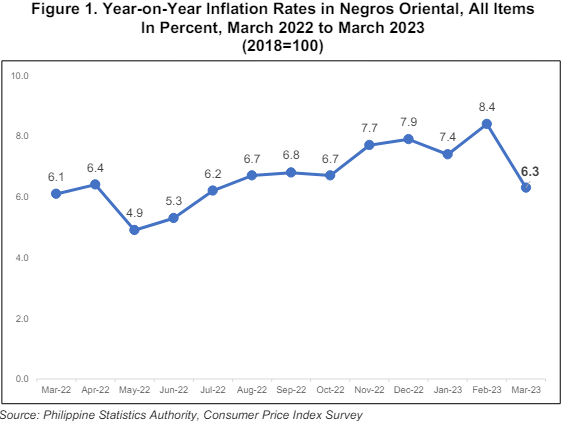
The province’s inflation rate has decreased from 8.4 percent in February 2023 to 6.3 percent in March 2023. In March of the previous year, inflation was lower at 6.1 percent. (Figure 1 and Table 2).
The province’s inflation rate was lower than the region’s inflation rate. (Table 1).
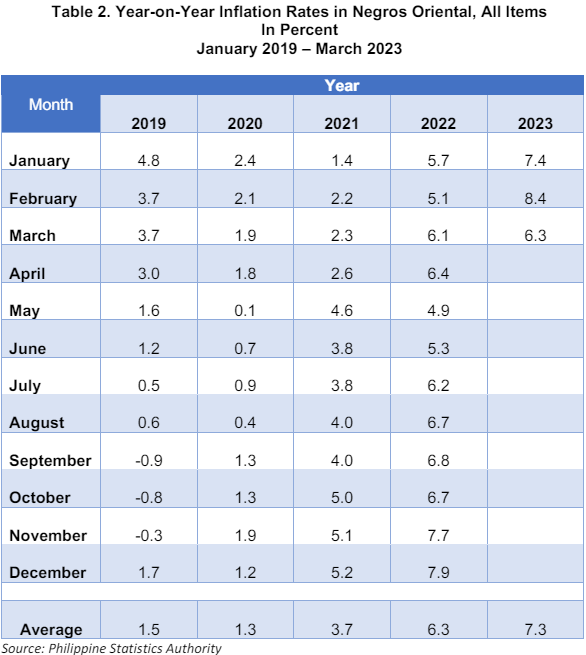
The inflation rates of the following commodity groups were higher during the month of March compared to the previous month: (Figure 2)
a. Alcoholic Beverages and Tobacco, 8.3 percent from 6.9 percent;
b. Clothing and Footwear, 6.3 percent from 6.0 percent;
c. Personal Care, and Miscellaneous Goods and Services, 3.1 percent from 2.9 percent; and
d. Recreation, Sport and Culture, 4.7 percent from 4.6 percent.
Meanwhile, the following commodity groups showed slightly decreased inflation rates during the month of March compared to the previous month;
a. Food and Non-Alcoholic Beverages, 10.0 percent from 13.9 percent;
b. Furnishings, Household Equipment and Routine Household Maintenance, 6.1 percent from 8.3 percent;
c. Health, 5.5 percent from 5.9 percent;
d. Housing, Water, Electricity, Gas and Other Fuels, 4.4 percent from 5.1 percent; and
e. Transport, -0.5 percent from 4.4 percent.
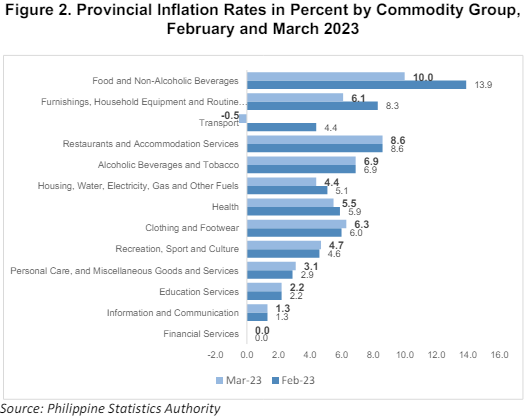
On the other hand, four commodity groups have retained their previous month’s inflation rates and these were: Restaurants and Accommodation Services at 8.6 percent; Education Services at 2.2 percent; Information and Communication at 1.3 percent; and Financial Services at 0.0 percent. (Figure 2).
Inflation for food in the province decreased to 10.0 percent from 14.2 percent in February 2023. In March 2022, food inflation in the province was lower at -2.0 percent. Moreover, the following food groups posted an increase in inflation rates: (Table 5)
a. Oils and Fats, from 38.2 percent to 39.1 percent;
b. Ready-made Food and Other Food products; from 15.4 percent to 16.5 percent; and
c. Milk, Other Dairy Products, and Eggs, from 7.1 percent to 7.4 percent.
Meanwhile, decreased in inflation rates were noted in the following food groups: (Table 5)
a. Fruits and Nuts, from 21.3 percent to 6.5 percent;
b. Meat and Other parts of Slaughtered Land Animals, from 13.4 percent to 9.6 percent;
c. Vegetables, Tubers, Plantains, Cooking Bananas and Pulses, from 20.5 percent to 12.3 percent;
d. Corn, from 17.7 percent to 6.9 percent;
e. Fish and Other Seafood, from 15.6 percent to 10.6 percent;
f. Flour, Bread and Other Bakery Products, Pasta Products, and Other Cereals, from 11.7 percent to 11.2 percent;
g. Rice, from 2.0 percent to 1.8 percent;
h. Sugar, Confectionery and Desserts, from 55.4 percent to 49.9 percent; and
i. Cereals, 7.0 percent to 3.5 percent.
APPROVED BY:
(SGD.) ARIEL T. FORTUITO
Chief Statistical Specialist



